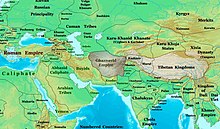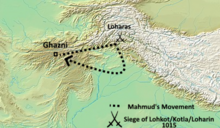| Siege of Lohkot (1015) | |||||||
|---|---|---|---|---|---|---|---|
| Part of Ghaznavid invasions | |||||||
| |||||||
| Belligerents | |||||||
| Ghaznavid Empire | Lohara dynasty | ||||||
| Commanders and leaders | |||||||
| Mahmud of Ghazni | Sangramraja of Kashmir | ||||||
| Casualties and losses | |||||||
| Mahmud suffered heavy casualties while retreating to Ghazna | |||||||
One of Mahmud's notable military campaigns during this period was the Siege of Lohkot in A.D. 1015. Positioned strategically in the Kashmir Valley, Lohkot (Iron Fort) presented a formidable challenge to Mahmud's forces due to its impregnable defenses. Despite persistent efforts, harsh winter conditions and reinforced defences compelled Mahmud to abandon the siege and retreat to Ghazni.
While Mahmud's campaigns were marked by some territorial gains, they also encountered setbacks. Despite setbacks, Mahmud's military endeavours played a crucial role in consolidating his power and expanding the influence of the Ghaznavids in the Indian subcontinent.
Background
Campaign Against the Shahis

After the death of Anandapala in A.D. 1012, Mahmud of the Ghaznavid Empire launched a renewed campaign against the Shahis. In A.D. 1013, Mahmud marched towards Nandana in the Salt Range, where he faced opposition from Trilochanapala, successor to Anandapala. Trilochanapala, appealed to Sangramaraja, the ruler of Kashmir, for assistance to defend his domains against the Ghaznavids in 1014 AD. Sangramaraja sent a large army, under the command of Tunga, to assist Trilochanapala. The Shahis and Kashmiri forces united to set up a camp in a valley north of Jhelum River. A small victory in a skirmish with the Ghaznavid scouts made Tunga overconfident. His underestimation of the Ghaznavid army resulted in a crushing defeat at the hands of Sultan himself. The surviving Kashmiri forces retreated back to the Kashmir. Following the defeat, Bhimapala and Trilochanapala retreated to Kashmir, while Mahmud seized the fort of Nandana, along with its treasures. A significant portion of the Shahi kingdom was annexed to Mahmud's empire. Trilochanapala fled to eastern Punjab, possibly to Sirhind.
Mahmud decided to use this opportunity to punish the King of Kashmir for allying himself with the Shahis. Sultan led the Ghaznavid forces in the military campaign into Kashmir in 1015 AD. The army marched to Jhelum, then continued along the Jhelum River, and attempted to use the Tosamaidan Pass to enter Kashmir. The only thing standing in his way was the impregnable stronghold of Lohkot (Iron Fort).
Siege
The Siege of Lohkot took place in A.D. 1015 during the reign of Mahmud, the ruler of the Ghaznavid Empire. It was a military campaign to quell chiefs and capture strategic forts in the Kashmir Kingdom. Lohkot, strategically positioned on the southern slopes of the central Pir Panjal Range, emerged as Mahmud's primary target due to its reputation for impregnability. Despite Mahmud's initial efforts, the fortress's formidable defenses proved insurmountable, leading to a protracted siege. Throughout the summer, Mahmud's army faced escalating challenges compounded by harsh winter conditions and heavy snowfall of Kashmir. Concurrently, the defenders of Lohkot fortified their positions with reinforcements, further complicating Mahmud's campaign.
Meanwhile, the Kashmirians under Sangramraja bolstered their position by reinforcing their troops, strengthening their defenses in anticipation of further confrontations with Mahmud's forces. As the siege persisted and the besieging army encountered mounting obstacles navigating the treacherous terrain, Mahmud confronted the grim reality of the situation. With dwindling resources and no viable alternatives, much of the army was lost due to attrition warfare of Kashmiris and to the winter. Mahmud made the difficult decision to abandon the siege and retreat towards Ghazni. The journey back to Ghazni was arduous and perilous for Mahmud and his troops, fraught with numerous hardships and obstacles. Treacherous marshes proved particularly hazardous, resulting in significant casualties among the retreating forces. Despite these setbacks, Mahmud demonstrated resilience, eventually leading the surviving portion of his army out of the challenging terrain.
Aftermath
The Siege of Lohkot serves as a reminder of the defences and harsh realities of warfare in the Kashmir during Mahmud's military campaigns. The strategic location of Lohkot and the challenges faced by Mahmud in his efforts to assert control over the region. However, Mahmud's efforts proved unsuccessful, and he was unable to achieve his objective. The campaign resulted in losses and hardships for Mahmud and his army. Mahmud retreated to Ghazni, unable to accomplish his goals he plans for second invasion.

The Sultan, having not yet given up on Kashmir, led a second military campaign in 1021 AD. The purpose was to overcome the fortress of Loharkot. The cold winter once again defeated the Ghaznavids. Mahmud gave up on further plans of expansion into Kashmir.
References
- History of India 1000 A D to 1707 A D. p. 16.
- ^ Ramakrishnan, S. (2001). History and Culture of the Indian People, Volume 05, The Struggle For Empire. Public Resource. Bharatiya Vidya Bhavan. pp. 11–13.
- ^ S N Sen (1987). Ancient Indian history and civilization. p. 330.
- Mohan, Krishna (1981). Early Medieval History of Kashmir: With Special Reference to the Loharas, A.D. 1003-1171. Meharchand Lachhmandas Publications.
- ^ Sadasivan, Balaji (2011). The Dancing Girl: A History of Early India. Institute of Southeast Asian Studies. p. 123. ISBN 978-981-4311-67-0.
- ^ Habib, Mohammad (1967). Sultan Mahmud of Ghaznin. S. Chand. p. 35.
- ^ Sharma, Lalchandra (1922). The Cambridge History Of India. p. 51.
- ^ Mehta, Jaswant Lal (1979). Advanced Study in the History of Medieval India. Sterling Publishers Pvt. Ltd. pp. 56–57. ISBN 978-81-207-0617-0.